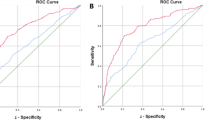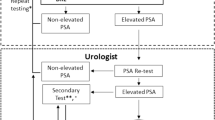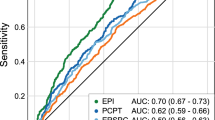Abstract
The aim of this study is to compare different tools for evaluating prostate-specific antigen (PSA) increase or decrease, such as PSA velocity and PSA slope. This study was conducted on 312 male patients evaluated with transrectal ultrasound-guided biopsy of prostate with six or more cores. Patients with at least three consecutive PSA measurements in at least 18 months entered the study. Prostate-specific antigen slope was estimated by the slope of the least-square regression line fit to PSA versus time in years; PSA velocity was calculated with 3 or more PSA arrays. Median age was 66 years (range 45–86). Overall 67 patients were affected by primary prostate cancer, 245 were controls without prostate cancer. Prostate-specific antigen slope and PSA velocity were significantly higher in patients with prostate cancer than in controls. At the ROC analysis, PSA slope evidenced better results than PSA velocity (area under the curve (AUC) 0.743 for PSA slope; AUC 0.663 for PSA velocity; P=0.037). At PSA slope (calculated with the least-square fit) equal to zero, the sensitivity resulted as being 94% with a specificity of 38.8%. In conclusion prostate-specific antigen slope calculated with three or more PSA assays permits longitudinal evaluation of PSA for prostate diagnosis. Prostate-specific antigen slope improves both sensitivity and specificity in prostate cancer diagnosis, compared with PSA velocity.
This is a preview of subscription content, access via your institution
Access options
Subscribe to this journal
Receive 4 print issues and online access
$259.00 per year
only $64.75 per issue
Buy this article
- Purchase on Springer Link
- Instant access to full article PDF
Prices may be subject to local taxes which are calculated during checkout


Similar content being viewed by others
References
Kirbly SR, Christmas TJ, Brawer MK . Prostate Cancer (2nd edition). Mosby (London, England), 2001, 59–71.
Young J (Ed). Cancer Incidence in Five Continents. Lyon, France, International Agency for Research on Cancer, vol VII 1997.
Catalona WJ, Smith DS, Ratliff TL . Measurement of prostate-specific antigen in serum as a screening test for prostate cancer. N Engl J Med 1991; 324: 1156–1161.
Woolf SH . Screening for prostate cancer with prostate-specific antigen. An examination of evidence. N Engl J Med 1995; 1333: 1401–1405.
Karazanashvili G, Abrahamsson PA . Prostate specific antigen and human glandular kallikrein 2 in early detection of prostate cancer. J Urol 2003; 169: 445–457.
Benecchi L, Pieri AM . Utilizzo pratico di una semplice rete neurale nella diagnosi dell'adenocarcinoma prostatico. Urologia 2005; 72: 78–84.
Carter HB, Pearson JD, Metter EJ, Brant LJ, Chan DW, Andres R et al. Longitudinal evaluation of prostate specific antigen levels in men with and without prostate disease. JAMA 1992; 267: 2215–2220.
Roobol MJ, Kranse R, De Koning HJ, Schroder FH . Prostate-specific antigen velocity at low prostate-specific antigens levels as screening tool for prostate cancer: results of second screening round of ERSPC (Rotterdam). Urology 2004; 63: 309–315.
D'Amico AV, Ming-Hui C, Roehl KA, Catalona WJ . Preoperative PSA velocity and the risk of death from postate cancer after radical prostatectomy. N Eng J Med 2004; 351: 125–135.
Khan MA, Carter HB, Epstein JI, Miller MC, Landis P, Walsh PW et al. Can prostate specific antigen derivatives and pathological parameters predict significant change in expectant management criteria for prostate cancer? J Urol 2003; 170: 2274–2278.
Carter HB, Pearson JD, Waclawiw Z, Metter EJ, Chan DW, Guess HA et al. Prostate-specific antigen variability in men without prostate cancer: effect of sampling interval on prostate-specific antigen velocity. Urology 1995; 45: 591–596.
Hanley JA, McNeil BJ . A method of comparing the areas under receiver operating characteristic curves derived from the same cases. Radiology 1983; 148: 839.
Hanley JA, McNeil BJ . The meaning and use of the area under a receiver operating characteristic (ROC) curve. Radiology 1982; 143: 29.
Catalona WL, Smith DS, Ratliff TL, Basler JW . Detection of organ-confined prostate cancer is increased through prostate-specific antigen-based screening. JAMA 1993; 270: 948–954.
Catalona WJ, Richie P, Ahmann FR, Hudson MA, Scardino PT, Flanigan RC et al. Comparison of digital rectal examination and serum prostate specific antigen in the early detection of prostate cancer: results of a multicenter clinical trial of 6,630 men. J Urol 1994; 151: 1283–1290.
Reissigl A, Klocker H, Pointner J, Fink K, Horninger W, Ennemoser O et al. Usefulness of the ratio free/total prostate-specific antigen in addition to total PSA levels in prostate cancer screening. Urology 1996; 48: 62–66.
Carter H, Morrell CH, Pearson JD, Brant LJ, Plato CC, Metter EJ et al. Estimation of prostatic growth using serial PSA measurements in men with and without prostate disease. Cancer Res 1992; 52: 3323–3328.
Brawer M, Beatie J, Wener M, Vessella R, Preston S, Lange P . for prostatic carcinoma with PSA : results of the second year. J Urol 1993; 150: 106–109.
Porter JR, Hayward R, Brawer MK . The significance of short term PSA change in men undergoing ultrasound guided prostate biopsy. J Urol 1994; 164: 293A.
Smith DS, Catalona WJ . Rate of change in serum prostate specific antigen levels as a method for prostate cancer detection. J Urol 1994; 152: 1168–1169.
Raaijmakers R, Wildhagen MF, Ito K, Paez A, De Vries SH, Roobol MJ et al. Prostate specific antigen in the European randomized study of screening for prostate cancer, Section Rotterdam. Urology 2004; 63: 316–320.
Takamiya R, Weinberg V, Young D, Sandler H, McLaughlin P, Roach M . A zero PSA slope in posttreatment prostate-specific antigen supports cure of patients with long-term follow-up after external beam radiotherapy for localized prostate cancer. Int J Radiat Oncol Biol Phys 2003; 56: 1073–1078.
Komatsu K, Wehner N, Prestigiacomo AF . Physiologic (intraindividual) variation of serum prostate-specific antigen in 814 men from a screening population. Urology 1996; 47: 343–346.
Acknowledgements
Paolo Vitolo and Marina Di Capua provided assistance with the statistics.
Author information
Authors and Affiliations
Corresponding author
Rights and permissions
About this article
Cite this article
Benecchi, L. PSA velocity and PSA slope. Prostate Cancer Prostatic Dis 9, 169–172 (2006). https://doi.org/10.1038/sj.pcan.4500866
Received:
Revised:
Accepted:
Published:
Issue Date:
DOI: https://doi.org/10.1038/sj.pcan.4500866
Keywords
This article is cited by
-
Sensitivity and specificity of prostate-specific antigen and its surrogates towards the detection of prostate cancer in sub-Saharan Africa: a systematic review with meta-analysis
African Journal of Urology (2023)
-
A big data-based prediction model for prostate cancer incidence in Japanese men
Scientific Reports (2023)
-
Prediction of disease progression indicators in prostate cancer patients receiving HDR-brachytherapy using Raman spectroscopy and semi-supervised learning: a pilot study
Scientific Reports (2022)
-
Reply: Influence of demographic factors and biochemical characteristics on the prostate-specific antigen (PSA) response to testosterone replacement therapy
International Journal of Impotence Research (2006)



